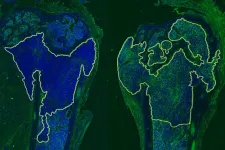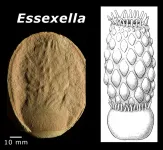(Press-News.org) Metastatic breast cancer has no cure and has proven stubbornly resistant to one of the most innovative and promising new cancer treatments: immunotherapy.
Now, researchers at Washington University School of Medicine in St. Louis have identified a way to treat the area surrounding breast tumors that have spread to bone so that such tumors become vulnerable to attack by the body’s immune system. When the researchers boosted the activity of certain immune cells, called T cells and macrophages, these immune cells worked together to clear metastatic breast tumors that had spread to the bones of mice, and continued to eliminate tumor cells that eventually returned.
The study is published March 8 in Cancer Discovery, a journal of the American Association for Cancer Research.
Macrophages are myeloid immune cells that attack cancer cells through the body’s innate immune response to general threats, such as tumors or viruses. Such macrophages further activate T cells by showing the T cells what they should be looking for, thereby harnessing the adaptive immune response as well. In this case, these macrophages present T cells with bits of recognizable tumor — called tumor antigens — from dead cancer cells, and the antigens direct the killing activities of T cells.
“After breast cancer has spread to other parts of the body, it becomes extraordinarily difficult to treat; current therapies can only try to slow it down,” said senior author Sheila A. Stewart, PhD, the Gerty Cori Professor of Cell Biology & Physiology. “About 70% of patients with metastatic breast cancer have tumors that have spread to their bones. Our study suggests we may be able to use two treatments — one to sensitize the myeloid tumor microenvironment to immunotherapy, and one to activate T cells — to target these bone metastases in a way that eliminates the tumor, prevents the cancer from returning and protects against bone loss in the process.”
Stewart, also a research member of Siteman Cancer Center at Barnes-Jewish Hospital and Washington University School of Medicine, and her colleagues found that blocking a molecule called p38MAPK reprograms the tumor microenvironment to become more vulnerable to attack by the immune system, including by immune cells and signaling molecules called anti-tumor cytokines. While a p38MAPK inhibitor alone reduced tumor size, it didn’t eliminate the tumor entirely. So, the researchers investigated whether adding another therapy that activates T cells and boosts their ability to find and destroy the tumor cells could be more effective at eliminating the metastatic cancer cells.
Common immunotherapies — called immune checkpoint inhibitors — are often described as “taking the brakes off” immune T cells, ushering them into battle against cancer. In this case, Stewart described the new approach as “hitting the gas” on T cells, supercharging them to be more effective against the cancer.
The researchers investigated two models of human metastatic breast cancer in mice and found that the metastatic tumors were eliminated in mice that received a p38MAPK inhibitor and an immune therapy called an OX40 agonist, which binds and activates T cells. All these mice were still alive and tumor-free at least 80 days after treatment. Among mice receiving either of the two treatments alone, only about half of them were still alive 60 days after treatment.
“If we targeted the microenvironment to make it more sensitive to T cells and simultaneously hit the gas on the T cells, all of the mice were cleared of the metastatic tumors,” Stewart said. “If we came back after two weeks and challenged the mice again with the same tumor cells, their immune systems could clear those cells as well. It appears that their immune systems developed long-term memory and knew to attack those returning cancer cells. The mice look like they’re basically vaccinated against the cancer.”
Three different OX40 agonists are being investigated in phase 2 clinical trials for cancer, including breast cancer. And p38MAPK inhibitors have been investigated in a number of inflammatory disorders, including rheumatoid arthritis and chronic obstructive pulmonary disease.
“We are hopeful that our study will interest companies that make these drugs, so that we can work toward developing a clinical trial that could investigate this strategy in patients with metastatic breast cancer,” Stewart said.
###
This work was supported by the National Institutes of Health (NIH), grant numbers R01 AG059244, CA217208, CA248493, T32CA113275 and F31CA271721-01; an American Cancer Society Research Scholar Award, grant number S10OD028483; and a Komen Foundation Career Catalyst Award, number CCR18548418. This project used the Pitt Biospecimen Core/UPMC Hillman Cancer Center Tissue and Research Pathology Services supported in part by NIH, grant number P30CA047904. This work also was supported by the Office of the Assistant Secretary of Defense for Health Affairs, through the Breast Cancer Research Program, under award No. BC181712; the Siteman Cancer Center Investment Program, under NCI Cancer Center Support Grant P30CA091842; the Fashion Footwear Association of New York; The Foundation for Barnes-Jewish Hospital Cancer Frontier Fund; a Centene Corp. contract (number P19-00559) for the Washington University-Centene ARCH Personalized Medicine Initiative; and an NIH MSTP T32 GM008244 training grant under the Medical Scientist Training Program at the University of Minnesota Medical School.
Faget DV, Luo X, Inkman MJ, Ren Q, Su X, Ding K, Waters MR, Raut GK, Pandey G, Dodhiawala PB, Ramalho-Oliveira R, Ye J, Cole T, Murali B, Zheleznyak A, Shokeen M, Weiss KR, Monahan JB, DeSelm CJ, Lee AV, Oesterreich S, Weilbaecher KN, Zhang J, DeNardo DG, Stewart SA. P38MAPKalpha stromal reprogramming sensitizes metastatic breast cancer to immunotherapy. Cancer Discovery. March 8, 2023.
About Washington University School of Medicine
WashU Medicine is a global leader in academic medicine, including biomedical research, patient care and educational programs with 2,800 faculty. Its National Institutes of Health (NIH) research funding portfolio is the third largest among U.S. medical schools, has grown 52% in the last six years, and, together with institutional investment, WashU Medicine commits well over $1 billion annually to basic and clinical research innovation and training. Its faculty practice is consistently within the top five in the country, with more than 1,800 faculty physicians practicing at 65 locations and who are also the medical staffs of Barnes-Jewish and St. Louis Children’s hospitals of BJC HealthCare. WashU Medicine has a storied history in MD/PhD training, recently dedicated $100 million to scholarships and curriculum renewal for its medical students, and is home to top-notch training programs in every medical subspecialty as well as physical therapy, occupational therapy, and audiology and communications sciences.
END
Two-pronged immunotherapy eliminates metastatic breast cancer in mice
Suggests a new approach for treating breast cancers that have spread to bone
2023-03-08
ELSE PRESS RELEASES FROM THIS DATE:
Researchers take a step towards turning interactions that normally ruin quantum information into a way of protecting it
2023-03-08
Researchers have found a way to predict the behavior of many-body quantum systems coupled to their environment. The work represents a way to protect quantum information in quantum devices, which is crucial for real-world applications of quantum technology.
In a study published in Physical Review Letters, researchers at Aalto University in Finland and IAS Tsinghua University in China report a new way to predict how quantum systems, such as groups of particles, behave when they are connected to the external environment. ...
Long-term exposure to nitrate in drinking water may be a risk factor for prostate cancer
2023-03-08
The nitrate ingested over the course of a person’s adult lifetime through the consumption of tap water and bottled water could be a risk factor for prostate cancer, particularly in the case of aggressive tumours and in younger men. This is the conclusion of a study conducted in Spain and led by the Barcelona Institute for Global Health (ISGlobal), a centre supported by the ”la Caixa” Foundation. The findings have been published in Environmental Health Perspectives.
The study also suggests that diet plays an important role. The researchers found that eating plenty of fibre, fruit/vegetables and vitamin C could reduce the negative effect ...
UNIST receives generous gift from BNK Kyongnam Bank
2023-03-08
UNIST and BNK Kyongnam Bank recently held a donation agreement ceremony in pursuit of creating a beautiful, biodiverse, and sustainable kitchen garden on UNIST campus.
A ceremony to commemorate and display gratitude for BNK Kyongnam Bank also took place on Friday, February 24, 2023. As part of its Carbon Neutral Campus Project, UNIST has been implementing a number of projects to improve sustainability on campus and in the surrounding community, including the creation of an ecological garden that ...
Seeking leukemia’s Achilles heel
2023-03-08
A team of researchers has discovered a potential therapeutic that can synergize with existing drugs to more effectively kill certain leukemia cells. The authors published their results on Jan. 19 in the journal Molecular & Cellular Proteomics.
Acute myeloid leukemia is a cancer of developing immune cells. It can manifest in all individuals, including the elderly and children. Only 30% of patients survive beyond five years of diagnosis
Unlike cancers of solid organs, AML is found in bodily fluids, such as blood. Like passengers ...
Men over 65 are at greater risk than women of skull fractures from falls
2023-03-08
Each year, more than 3 million people ages 65 and older are treated in emergency departments for fall injuries. Head trauma is the leading cause of serious injury with skull fractures being reported as a serious outcome. According to the 2016 National Trauma Database annual report, females account for 58 percent of these falls.
Because geriatric females have an increased rate of falls and facial fractures, determining if they also are at an increased risk of skull fractures is crucial. Currently, research ...
Highlight facts or appeal to feelings? The psychology of persuading individuals to contribute to a collective goal
2023-03-08
Researchers from Fudan University, China Europe International Business School, and Peking University published a new Journal of Marketing article that examines how marketers can use different messaging to persuade individuals to contribute to a collective goal. The study addresses the specific question of the type of message—fact-based vs. affected-based—that is more effective in eliciting participation based on how near the goal is to completion.
The study, forthcoming in the Journal ...
Just add water: How diluting ouzo liquor could lead to better emulsions
2023-03-08
It sounds like a party trick: Add water to the clear, licorice-flavored ouzo liquor, and watch it turn cloudy. This “ouzo effect” is an example of an easy way to make highly stable emulsions — or mixtures of liquids that don’t like being together, like vinaigrettes — but nobody has yet fully understood how it works. Now, researchers report in ACS Central Science that the secret may lie in the unique structure of the emulsion’s droplets.
Ouzo is a popular liquor enjoyed throughout Greece, ...
Paving a smoother path to manuscript publication
2023-03-08
Shane Harper, DMS, PA-C, knows how difficult it is to launch a medical research journal and get it into the orbit of the scientific community. In 2022 he became the founding editor-in-chief for the West Texas Journal of Medicine, which published its inaugural issue in December.
By establishing a medical research publication, Harper and the journal’s editorial board seek to provide an online publication that distributes original medical and health sciences-related research in a forum free of common predatory publication practices to ...
Paleontologists flip the script on anemone fossils
2023-03-08
Billions of sea anemones adorn the bottom of the Earth’s oceans — yet they are among the rarest of fossils because their squishy bodies lack easily fossilized hard parts. Now a team of paleontologists has discovered that countless sea anemone fossils have been hiding in plain sight for nearly 50 years.
In a newly published paper in the journal Papers in Palaeontology, University of Illinois Chicago’s Roy Plotnick and colleagues report that fossils long-interpreted ...
Mezcal worm in a bottle: DNA evidence suggests a single moth species
2023-03-08
A new study published in PeerJ Life & Environment looked to identify the species of larva found in bottles of Mezcal. Mezcal is a distilled alcoholic beverage made from any type of agave.
Are people consuming larvae of the skipper butterfly Aegiale hesperiaris, or the larva of the moth Comadia redtenbacheri, the latter which is thought to be declining in numbers in recent years? Or is the worm the larva of a weevil, or another unidentified insect species? Researchers used DNA-based identification analysis of larvae inside 21 commercially ...
LAST 30 PRESS RELEASES:
Study showcases resilience and rapid growth of “living rocks”
Naval Research Lab diver earns Office of Naval Research 2025 Sailor of the Year
New Mayo-led study establishes practical definition for rapidly progressive dementia
Fossil fuel industry’s “climate false solutions” reinforce its power and aggravate environmental injustice
Researchers reveal bias in a widely used measure of algorithm performance
Alcohol causes cancer. A study from IOCB Prague confirms damage to DNA and shows how cells defend against it
Hidden viruses in wastewater treatment may shape public health risks, study finds
Unlock the power of nature: how biomass can transform climate mitigation
Biochar reshapes hidden soil microbes that capture carbon dioxide in farmland
Reducing saturated fat intake shows mortality benefit, but only in high-risk individuals
Manta rays create mobile ecosystems, study finds
Study: Mixed results in using lipoic acid to treat progressive multiple sclerosis
Norbert Holtkamp appointed director of Fermi National Accelerator Laboratory
New agentic AI platform accelerates advanced optics design
Biologists discover neurons use physical signals — not electricity — to stabilize communication
Researchers discover that a hormone can access the brain by hitchhiking
University of Oklahoma researcher awarded funding to pursue AI-powered material design
Exploring how the visual system recovers following injury
Support for parents with infants at pediatric check-ups leads to better reading and math skills in elementary school
Kids’ behavioral health is a growing share of family health costs
Day & night: Cancer disrupts the brain’s natural rhythm
COVID-19 vaccination significantly reduces risk to pregnant women and baby
The role of vaccination in maternal and perinatal outcomes associated with COVID-19 in pregnancy
Mayo Clinic smartwatch system helps parents shorten and defuse children's severe tantrums early
Behavioral health spending spikes to 40% of all children’s health expenditures, nearly doubling in a decade
Digital cognitive behavioral treatment for generalized anxiety disorder
Expenditures for pediatric behavioral health care over time and estimated family financial burden
Air conditioning in nursing homes and mortality during extreme heat
The Alps to lose a record number of glaciers in the next decade
What makes a good proton conductor?
[Press-News.org] Two-pronged immunotherapy eliminates metastatic breast cancer in miceSuggests a new approach for treating breast cancers that have spread to bone






